Mystery Menu
I'm just back from an unforgettable and utterly stimulating four-night trip to Japan. Though my kanji knowledge often served me well, I now think of Japan as the land of incomprehensible writing. I say that because I kept encountering words that even native speakers couldn't decipher.
At the lovely and touching wedding I attended in Karuizawa (Nagano Prefecture), my Japanese tablemates and I puzzled over the menu (all presented in a 4-point font, or so it seemed). Even though they understood quite a bit, they gave up on other parts. See if you can figure out what the hotel served us. If you know French, it'll help you greatly! The answers will come at the end. By the way, the blue line in each section is the category name. Bon appetit!
前菜
アボガドと海老のディップ
ポークリェット
旬の野菜のムース
海の幸のタルタル イクラと共に
色どり野菜と鶏のコンフィ
生ハムフルーツ
季節の野菜のスティック バジルソース
I'll give you a moment to digest all that before we continue.

Photo Credit: Eve Kushner
The wedding took place in this serene church in the woods. Notice the reflection in the window!
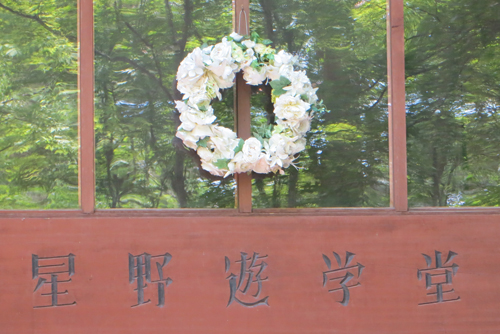
Photo Credit: Eve Kushner
A close-up of the kanji over the door. The meaning doesn't immediately present itself. Rather, it comes little by little. The nearby hotel resort (which the bridal party stayed in) was called 星のや (ほしのや), named after founder Kunitsugu Hoshino (星野国次). His first significant act on that land in 1914 (exactly a century ago!) was to dig out a hot spring bath. The first two kanji engraved above represent his surname, 星野. Then we find 遊学堂. The 遊学 (ゆうがく) means "studying abroad" or "traveling to study." The bride and I met in 2002 when she was studying abroad in the San Francisco area, but I doubt that's what this signifies! Actually, one website says that Kanzo Uchimura (内村鑑三), who established the church, believed that playing (遊) is also learning (学) and that if you find something truly fun, you can learn from it. (I love this way of thinking!) Finally, 堂 (どう) is "hall." That one makes sense!
Here's more of the menu:
スープ
季節のポタージュ
魚料理
真鯛のポワレ ソースマリニエール
肉料理
ハーブの香りを閉じ込めた国産牛の岩塩包み焼き
ソースヴァンルージュ
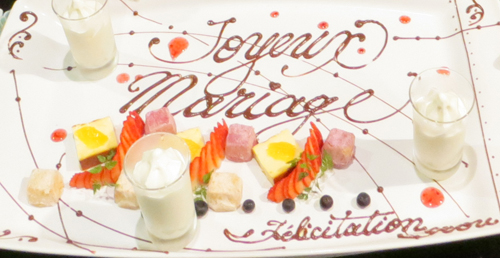
The night before the wedding, the bride and her friends ate at a restaurant on the hotel grounds. Though it served Japanese food, the restaurant had a French name. Perhaps that's why the staff used French to write "Happy marriage" and "Congratulation(s)" on the dessert platter. I suspect, though, that the real reason for the roman letters is that it's hard to draw kanji in icing!
Before sharing the answers, I'll introduce the newest essay, which is on 渡. Among many other things, this kanji helps to form words about going overseas. I'm thinking of such terms as these:
渡日 (とにち: visiting Japan; moving to Japan) to go overseas + Japan
渡仏 (とふつ: visiting France; moving to France) to go overseas + France
These words suddenly seem quite relevant to my trip to a mini-France in the woods of Japan!
Here's a sneak preview of essay 1636 on 渡:
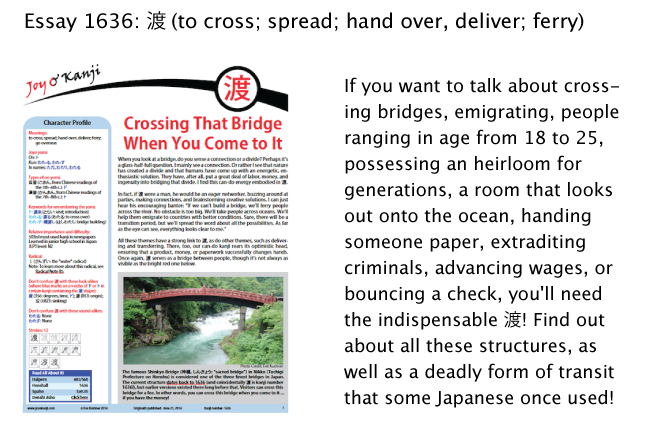
And now for the menu translations!
前菜 (ぜんさい: hors d'oeuvres)
アボガドと海老のディップ: avocado and shrimp dip
海老 (えび: shrimp)
ポークリェット: pork rillettes (as hors d'oeuvres?!)
旬の野菜のムース: mousse made of seasonal vegetables
旬 (しゅん: season (for specific products)); 野菜* (やさい: vegetable)
海の幸のタルタル イクラと共に: seafood tartare with salted salmon roe
海の幸 (うみのさち: seafood, or lit. "the blessing of the sea"); タルタル (tartare); イクラ (salted salmon roe); 共に (ともに: together, with)
色どり野菜と鶏のコンフィ: colorful vegetables and chicken confit
色どり (いろどり: colorful); 鶏 (にわとり: chicken)
生ハムフルーツ: fruits with raw ham
生 (なま: raw)
季節の野菜のスティック バジルソース: julienned ("sticks" of) seasonal vegetables in a sauce made of basil (a word that completely eluded me!)
季節* (きせつ: season)
スープ: soup
季節のポタージュ: seasonal thick soup, with ポタージュ coming from the French potage, "thick soup, especially one with a cream base." (Incidentally, potage has no relation to potatoes, though I was sure it must.)
魚料理 (ぎょりょうり: seafood-based cuisine)
真鯛のポワレ ソースマリニエール: sea bream pan-roasted in butter with a "mariniere" sauce (which is a "mariner's sauce" or a "seafood sauce," not "marinara sauce," as I thought!)
真鯛 (まだい: species of red Pacific sea bream); ポワレ (butter roasting, from the French poêle, "frying pan")
肉料理 (にくりょうり: meat dish)
ハーブの香りを閉じ込めた国産牛の岩塩包み焼き: Japanese beef wrapped in rock salt to lock in the scent of herbs and then roasted
香り (かおり: scent); 閉じ込める (とじこめる: to seal); 国産牛 (こくさんぎゅう: domestically produced beef); 岩塩 (がんえん: rock salt); 包み焼き (つつみやき: wrapped and roasted)
ソースヴァンルージュ: red wine sauce, from the French vin rouge, "red wine"
I guess they wanted us to be really surprised by what arrived at the table! Next time I attend a Japanese wedding, I'll bone up on my French first!
I'll leave you with a few more images of the beautiful Hoshinoya resort in Karuizawa, which I wholeheartedly recommend.

Photo Credit: Eve Kushner
I had a two-room "apartment" to myself! After showing me to my room, they presented a gelatinous dessert that looked like the ocean. I have absolutely no memory of how it tasted. Jet lag wiped out much of my memory last weekend. I floated along happily, and the more exhausted I was, the more uninhibited I was about speaking Japanese. I finally slept well at this resort and found myself tongue-tied the next day!
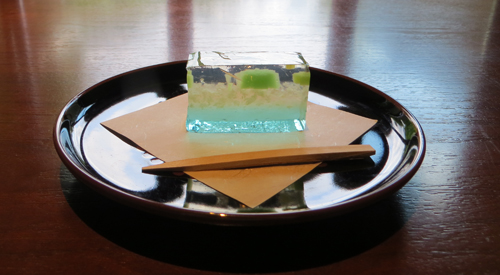
Photo Credit: Eve Kushner
Dessert close-up. Wonder what that green stuff was!

Photo Credit: Eve Kushner
Geta (traditional sandals) awaited me at the entrance to the garden. They taunted me, too. Having just posted my 靴 (shoes; footwear) essay, I found myself taunted at all turns by traditional shoes and signs about shoes that I had spotted too late to include in the essay! In Tokyo Station I even saw a monk wearing 草鞋 (わらじ: straw sandals). I felt exhilarated to know what they were from having written that essay!
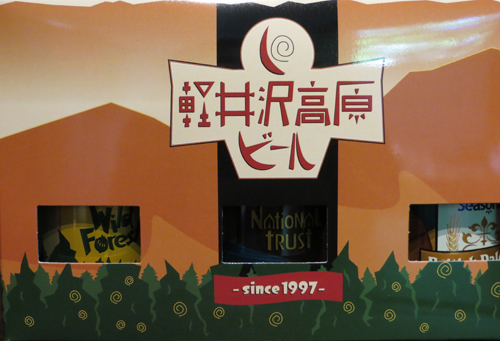
Photo Credit: Eve Kushner
In the hotel gift shop, you can buy a brand of beer called 軽井沢高原 where 軽井沢 (かるいざわ) is the town name and 高原 (こうげん) means "highland." I don't know how the beer tastes, but I love the font!
Have a great weekend!

Comments